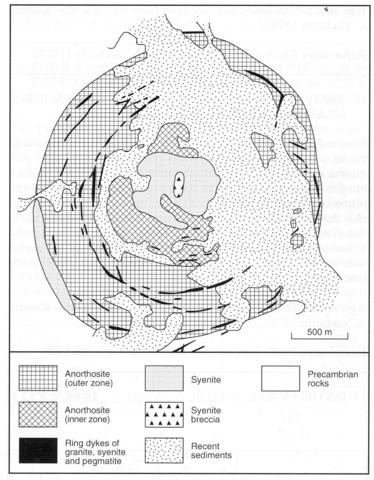stripes
The circular, funnel-shaped Abontorok intrusion is 2.6 km in diameter and has a low central hill of quartz syenites and syenite breccias surrounded by an arcuate depression underlain principally by anorthosites, which are obscured by recent sediments in the north and east. The anorthosites are cut by thin, arcuate ring-dykes of peralkaline granite, syenite and pegmatite and are expressed topographically as ridges. The anorthosites form inner and outer zones (Karche and Moreau, 1977; Husch and Moreau, 1982; Brown et al., 1989) which in the outermost 100 m of the outer zone pass into anorthositic gabbros. The inner zone, in particular, is characterised by the parallel orientation of platy plagioclase crystals which impart an inward dipping foliation that generally decreases in dip outwards. With increasing radial distance from the centre plagioclase decreases modally, olivine and opaque minerals increase but clinopyroxene shows no clear trend (Husch and Moreau, 1982). In the outer anorthosites apatite, biotite, hastingsitic and ferrohastingsitic amphibole occur interstitially, while in the inner ones there is a little quartz and alkali feldspar. Detailed textural and mineralogical accounts are given by Brown et al. (1989). The central syenite is a leucocratic rock of equant alkali feldspar, ferroaugite and aegirine-augite, ferroan richterite and arfvedsonite, opaque phases, quartz and accessory apatite and zircon. The central breccia comprises angular fragments of 1-30 cm, rarely up to 1 m, in diameter of syenite, rare anorthosite and leucogabbro in a matrix composed almost entirely of Or-rich feldspar. The ring-dykes include granite and quartz syenite, the latter being composed of alkali feldspar, quartz, pale green pyroxene overgrown by dark green pyroxene, brown-green, often zoned to greenish blue, amphibole, an opaque oxide and rare biotite (Brown et al., 1989). Chemical data, including Rb and Sr isotopic ratios, are available in Brown et al. (1989).
BROWN, W.L., MOREAU, C. and DEMAIFFE, D. 1989. An anorthosite suite in a ring-complex: crystallization and emplacement of an anorogenic type from Abontorok, Air, Niger. Journal of Petrology, 30: 1501-40.HUSCH, J.M. and MOREAU, C. 1982. Geology and major element geochemistry of anorthositic rocks associated with Paleozoic hypabyssal ring complexes, Air massif, Niger, West Africa. Journal of Volcanology and Geothermal Research, 14: 47-66.KARCHE, J.-P. and MOREAU, C. 1977. Note préliminaire sur le massif subvolcanique à structure annulaire d'Abontorok (Aïr-Niger). Comptes Rendus Hebdomadaires des Séances de l'Académie des Sciences, Paris, 284D: 1259-62.MOREAU, C. 1987. Les complexes anorogéniques à suite anorthositique de l'Aïr (Niger): contribution à l'étude des anorthosites. Bulletin de la Société Géologique de France, 8(3): 115-22.

